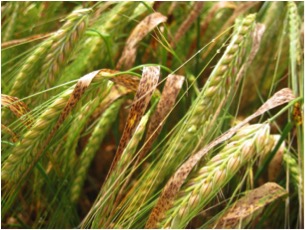Ramularia
Ramularia leaf spot and abiotic leaf spots (also known as Physiological Leaf Spots PLS) can cause extensive damage to the upper leaves in spring and winter barley once crops are past the flowering stage of growth. This can cause extensive losses in yield and quality. Typical symptoms of Ramularia comprise small rectangle lesions on the leaf, which are brown in colour. They are surrounded by a yellow halo when present on green leaves. They may resemble net blotch lesions superficially. Following high levels of infection, the leaves may rapidly lose green leaf. Lesions will still be clearly defined as black spots on dead leaves. The translucent spores can be seen on the surface of dead levels.
Yield losses in spring barley can be as high as 0.9 tonnes per hectare. There is an added problem of an increase in screenings (percentage of grains smaller than 2.5 mm).

So far, three key types of leaf spots which have been identified, abiotic or oxidative stress (sometimes called sun scorch or physiological leaf spot PLS), those caused by the fungus Ramularia collo-cygni which cause the disease ramularia leaf spot, and a third type where damage to the leaf wax following the application of certain fungicides causing plant tissue to die. These three types of leaf spot can occur together.
Damage to a leaf from oxidative stress can lead to more ramularia, whilst ramularia produces plant toxins which make plants more susceptible to oxidative stress. For growers, the best approach is to be more concerned at keeping the leaves green rather than be too concerned in identifying the different causes.
Ramularia collo-cygni can be detected on the seed. It can also be detected with diagnostics inside leaves at tillering before any symptoms are seen. The disease can also be dispersed via wind-dispersed spores. Although visual symptoms can sometimes develop on the lower leaves when they die, symptoms are not found on healthy green leaves until the crop flowers. This suggests there may be a crop stress event or physiological trigger for symptoms to develop. Once crops start to flower, symptoms can suddenly appear on the upper two leaves. Symptoms tend to be less severe lower down the canopy.
No variety is immune, but some are worse than others. In the Scottish spring barley crop, Optic is intermediate, with Belgravia, Decanter, Power, Westminster and Riviera showing less damage and Forensic suffering more than most. In practice, all varieties will need protection in areas where spotting regularly occurs.
When the spots first started to appear in the mid '90s, it was assumed that the mildew resistance gene (mlo) was partly to blame for an increase in leaf spots, since the mildew resistant variety Chariot was affected more than other varieties. It is not so clear cut since Optic does not have the mlo gene but it is still affected by this complex, but once leaf spots get going in a variety, it is possible the mlo gene may accelerate the leaf damage.
The phytotoxin rubellin D is associated with Ramularia symptoms. This is thought to be produced by the fungus when the barley host is stressed. Under light conditions, rubellin D causes oxidtative stress, leading to plant cell damage causing typical leaf symptoms. Rubellin D may also increase ethylene production, which leads to early ripening. This means the crop dies back early and the crop loses yield.
It is suggested Ramularia collo-cygni is an endophytic fungus, (a fungus which lives inside barley). It can infect the barley crop via the seed, or infect leaves via stomata (leaf pores). Leaf infection tends to occur in the summer and is most common where leaves remain wet for long periods (from June rainfall or dew on the leaves). As long as the barley crop is not stressed and growing in the vegetative stage, no symptoms of Ramularia leaf spot are present. Crop stress caused by the crop flowering, or stress from poor crop nutrition or from the use of harsh formulations affecting the leaf wax, induce the fungus to produce the phytotoxin rubellin D. This phytotoxin can produce ethylene under sunlight, and the production of ethylene will lead to early ripening of the crop. These events may lead to the typical leaf symptoms and allow the Ramularia fungus to sporulate on the underside of leaves via the leaf damage.
If Ramularia collo-cygni is thought of in terms as an endophyte within the crop, it means fungicides may cause a reduction in symptoms via two ways. The first is direct action as a fungicide, the second is by the physiological effects some fungicides have to prolong the greening of the crop.
High-risk conditions are wet weather followed by dry sunny spells during May and June. Protect crops with fungicide at boot stage (awns peeping) to prevent leaf spots from developing. The impact of seed infection is under investigation to see if seed treatments may be one approach to reduce the amount of ramularia in the plant.
For monthly, timely advice on Rumularia, visit our Crop Health Updates webpage.
Related information
Sign up to the FAS newsletter
Receive updates on news, events and publications from Scotland’s Farm Advisory Service
